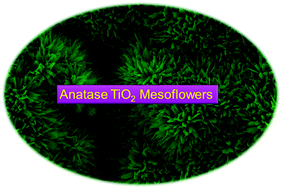Flower-shaped anatase TiO2 mesostructures with excellent photocatalytic properties†
Abstract
The present paper reports a simple route to fabricate high surface area anatase TiO2 mesoflowers from electrospun TiO2–SiO2 composite nanostructures. Electrospun fiber- and rice-shaped TiO2–SiO2 composite nanostructures upon treatment with concentrated alkali (NaOH) under hydrothermal conditions (180 °C) result in chemical transformation of the TiO2 and in situ etching of SiO2 to give sodium titanates. The sodium titanate upon acidification followed by a low temperature sintering (180 °C) results in 3D TiO2 mesoflowers. The material is found to be superior to the commercial P-25 in photocatalysis.


 Please wait while we load your content...
Please wait while we load your content...